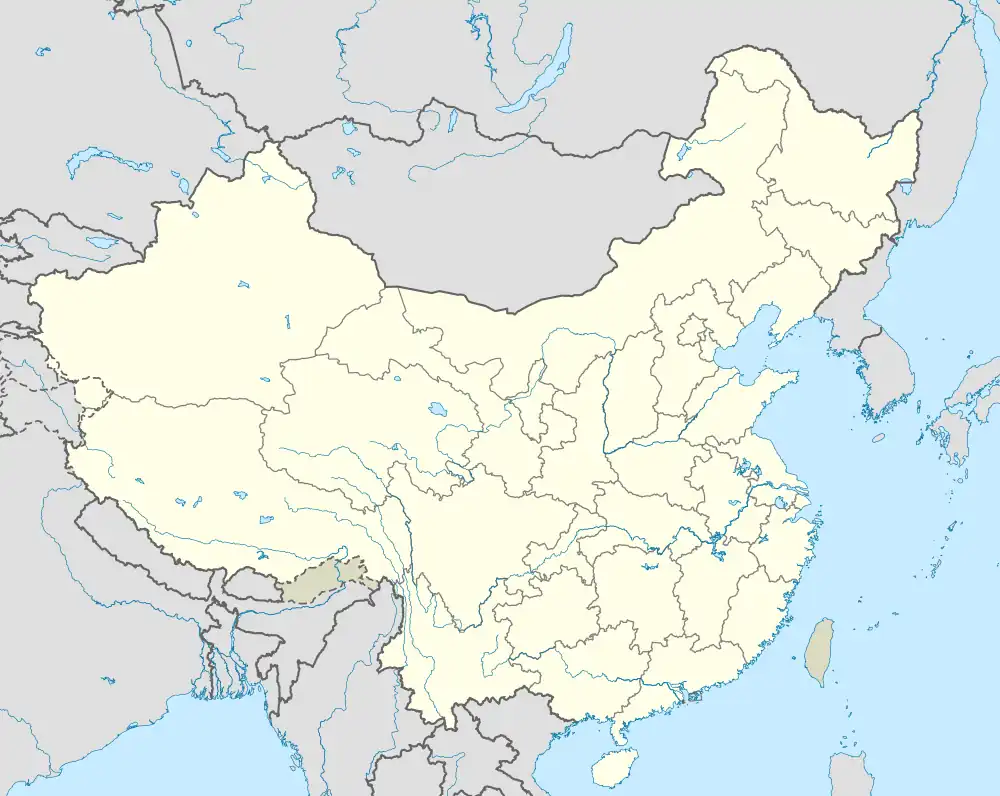Miaocheng Area
庙城地区 Miaocheng Town (庙城镇) | |
|---|---|
.jpg.webp) Aerial view of Gaogezhuang Railway Station, 2021 | |
.png.webp) Location in Huairou District | |
 Miaocheng Area  Miaocheng Area | |
| Coordinates: 40°17′30″N 116°37′22″E / 40.29167°N 116.62278°E | |
| Country | China |
| Municipality | Beijing |
| District | Huairou |
| Village-level Divisions | 2 communities 18 villages |
| Area | |
| • Total | 31.06 km2 (11.99 sq mi) |
| Elevation | 44 m (144 ft) |
| Population (2020) | |
| • Total | 40,883 |
| • Density | 1,300/km2 (3,400/sq mi) |
| Time zone | UTC+8 (China Standard) |
| Postal code | 101401 |
| Area code | 010 |
Miaocheng Area (simplified Chinese: 庙城地区; traditional Chinese: 廟城地區; pinyin: Miàochéng Dìqū) is an area and a town situated on southern Huairou District, Beijing, China. It shares border with Huairou Town and Longshan Subdistrict to its north, Yangsong Town to its east, Niulanshan and Zhaoquanying Towns to its south, Beishicao and Qiaozi Towns to its west. The 2020 census had determined the town's population to be 40,883.[1]
In 1127, Xiao Dali, the second empress consort of Emperor Xingzong of Liao, constructed a temple and a fortification in the region. The settlement here later got the name Miaocheng (Chinese: 庙城; lit. 'Temple Fort').[2]
History
| Time | Status | Within |
|---|---|---|
| Ming and Qing dynasty | Caijiali | Huairou County, Shuntian Prefecture |
| 1912 - 1948 | 1st District | Huairou County, Capital Area |
| 1948 - 1949 | 7th District | |
| 1949 - 1950 | 7th District
4th District Chengguan District |
Huairou County, Hebei |
| 1950 - 1958 | Huogezhuang Township
Zhengzhong Township | |
| 1958 - 1959 | Bayi People's Commune
Dongfeng People's Commune |
Huairou County, Beijing |
| 1959 - 1961 | Chengguan People's Commune
Qiaozi People's Commune | |
| 1961 - 1983 | Miaocheng People's Commune | |
| 1983 - 1990 | Miaocheng Township | |
| 1990 - 2001 | Miaocheng Town | |
| 2001 - 2002 | Huairou District, Beijing | |
| 2002 - present | Miaocheng Area (Maiocheng Town) |
Administrative divisions
As of the year 2021, Miaocheng Area had 20 subdivisions, including 2 communities and 18 villages:[3]
| Subdisvision Names | Name Transliterations | Type |
|---|---|---|
| 庙城 | Miaocheng | Community |
| 金山 | Jinshan | Community |
| 高两河 | Gaolianghe | Village |
| 李两河 | Lilianghe | Village |
| 小杜两河 | Xiao Dulianghe | Village |
| 刘两河 | Liulianghe | Village |
| 大杜两河 | Da Dulianghe | Village |
| 肖两河 | Xiaolianghe | Village |
| 赵各庄 | Zhaogezhuang | Village |
| 霍各庄 | Huogezhuang | Village |
| 焦村 | Jiaocun | Village |
| 彩各庄 | Caigezhuang | Village |
| 庙城 | Miaocheng | Village |
| 桃山 | Taoshan | Village |
| 王史山 | Wangshishan | Village |
| 孙史山 | Sunshishan | Village |
| 高各庄 | Gaogezhuang | Village |
| 郑重庄 | Zhengzhongzhuang | Village |
| 西台上 | Xitai Shang | Village |
| 西台下 | Xitai Xia | Village |
See also
References
- ↑ "北京市怀柔区第七次全国人口普查公报_重点工作_怀柔区人民政府网站". www.bjhr.gov.cn. Retrieved 2022-10-24.
- 1 2 Zhong hua ren min gong he guo zheng qu da dian. Bei jing shi juan. Li li guo, Li wan jun, Wu shi min, 李立国., 李万钧., 吴世民. Bei jing: Zhong guo she hui chu ban she. 2013. ISBN 978-7-5087-4058-4. OCLC 910451741.
{{cite book}}: CS1 maint: others (link) - ↑ "2021年统计用区划代码和城乡划分代码". www.stats.gov.cn. Retrieved 2022-10-24.